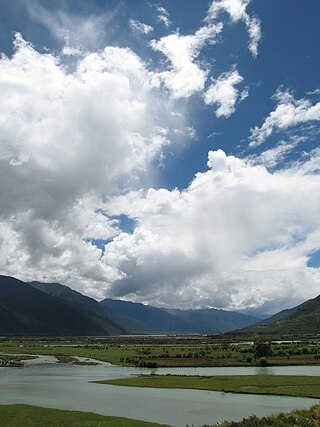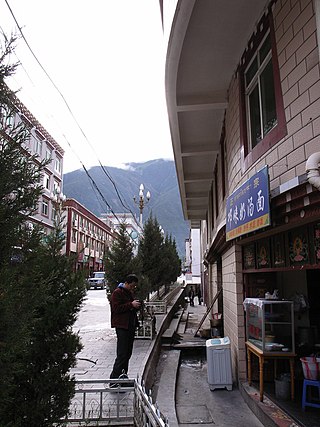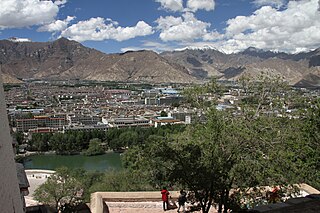Related Research Articles
Tai Situpa is one of the oldest lineages of tulkus in the Kagyu school of Tibetan Buddhism In Tibetan Buddhism tradition, Kenting Tai Situpa is considered as emanation of Bodhisattva Maitreya and Guru Padmasambhava and who has been incarnated numerous times as Indian and Tibetan yogis since the time of the historical Buddha.

Nyêmo is a county in the Lhasa west of the main center of Chengguan, Tibet. It lies on the north bank of the Yarlung Tsangpo River, the northern part of the Brahmaputra. The county has an area of 3,276 square kilometres (1,265 sq mi), and as of 2011 had a population of 30,844 people, mostly engaged in agriculture or herding.

Tashi Lhunpo Monastery, founded in 1447 by the 1st Dalai Lama, is the traditional monastic seat of the Panchen Lama, and an historically and culturally important monastery in Shigatse, the second-largest city in Tibet.

Karuo District is a district in Qamdo, the district is synonymous referred to as Chamdo, Qamdo, or Chengguan in the Tibet Autonomous Region of China, and the seat of government of Qamdo. Karuo has an area of 10,700 km2 and a population of 78,000, of which 90% are Tibetan. The average temperature is 7.6 °C, with average temperatures of −2.3 °C in January and 16.3 °C in July. The average precipitation is 467 mm per year.

Nagqu is a prefecture-level city in the north of the Chinese autonomous region of Tibet. On May 7, 2018, the former Nagqu Prefecture was officially declared the sixth prefecture-level city in Tibet after Lhasa, Shigatse, Chamdo, Nyingchi and Shannan. The regional area, covering an area of 450,537 km2 (173,953 sq mi), is bordered by Bayingolin and Hotan Prefectures of Xinjiang to the north, Haixi, Yushu Prefectures of Qinghai and Chamdo to the east, Nyingchi, Lhasa and Shigatse to the south, Ngari Prefecture to the west. As of the 2010 census, it had a population of 462,381.

Han Hong, is a Chinese singer and songwriter of mixed Tibetan and Han ethnicity. Like her mother, a Tibetan singer, Han Hong is able to shift quite easily from piercing high pitches to soft low tones. Han Hong is one of the most popular Chinese female musicians who specializes in a variety of Chinese folk music. Most of Han's work reflect the Tibetan culture, but Han also use elements of Jazz, R-n-B, Rock-n-Roll and Latin music in her music work.
Dorjidak Gompa or Tupten Dorjidak Dorjé Drak Éwam Chokgar is a Tibetan Buddhist monastery and one of the Nyingma school's "Six Mother Monasteries" in Tibet. It is located in the Lhoka (Shannan) Prefecture in the south of the Tibet Autonomous Region, older southeastern Ü-Tsang.

Ngapoi Ngawang Jigme was a Tibetan senior official who assumed various military and political responsibilities both before and after 1951 in Tibet. He is often known simply as Ngapo in English sources.

The Central Institute of Higher Tibetan Studies, formerly called Central University for Tibetan Studies (CUTS), is a Deemed University founded in Sarnath, Varanasi, India, in 1967, as an autonomous organisation under Union Ministry of Culture. The CIHTS was founded by Pt. Jawahar Lal Nehru in consultation with Tenzin Gyatso, the 14th Dalai Lama, with the aim of educating Tibetan youths in exile and Himalayan border students as well as with the aim of retranslating lost Indo-Buddhist Sanskrit texts that now existed only in Tibetan, into Sanskrit, to Hindi, and other modern Indian languages.

Lhalu Tsewang Dorje commonly known as Lhalu, Lhalu Se, or Lhalu Shape, was a Tibetan aristocrat and politician who held a variety of positions in various Tibetan governments before and after 1951.

Batang County is a county located in western Garzê Tibetan Autonomous Prefecture, Sichuan Province, People's Republic of China. Government address: Xiaqiong Town, Batang County, Ganzi, Sichuan 627650. Area code: 0836. The main administrative centre is known as Batang Town or Xiaqiong Town.

Alan Dawa Dolma, known professionally as Alan, is a Tibetan singer and she is known for her signature "Tibetan wail", often incorporated into her music. She is a graduate of the PLA Academy of Art, majoring in vocal music and erhu, which she has played since childhood.
Karma Gon Monastery, the original monastery of the Karma Kagyu sect of Tibetan Buddhism, was founded in the 12th century by Düsum Khyenpa, the 1st Karmapa Lama in eastern Tibet at the age of 76. Karma Gon, is located on the eastern bank of the Dzachu River in Chamdo, eastern Tibet. Karma Dansa was the cradle of the karma kagyupas. When established the Karmapa had gathered 1000 monks around him here. Karma Gon was named as Karma Dansa as an administrative unit and the Chinese Ming Court enlarged the monastery’s jurisdiction by adding the Mekong’s middle and upper reaches. It was then also called Gama Dansa Si in Chinese.
Ngawang Tashi Drakpa was a king of Tibet who ruled in 1499–1554 and 1556/57–1564. He belonged to the Phagmodrupa Dynasty which was the dominating regime in Tibet from 1354 to 1435 and maintained a degree of authority until the early 17th century. His rule is sometimes considered to be the last of importance in the history of the dynasty.

The Battle of Chamdo occurred from 6 to 24 October 1950. It was a military campaign by the People's Republic of China (PRC) to take the Chamdo Region from a de facto independent Tibetan state. The campaign resulted in the capture of Chamdo and the annexation of Tibet by the People's Republic of China.
Sanggye Pal was a Tibetan Imperial Preceptor (Dishi) at the court of the Mongol-led Yuan dynasty of China. He hailed from Sakya which was the foremost monastic regime in Tibet in this period. He held the dignity from 1305 to his death in 1314.

Lhasa is a prefecture-level city, one of the main administrative divisions of the Tibet Autonomous Region of China. It covers an area of 29,274 square kilometres (11,303 sq mi) of rugged and sparsely populated terrain. Its capital and largest city is Lhasa, with around 300,000 residents, which mostly corresponds with the administrative Chengguan District, while its suburbs extend into Doilungdêqên District and Dagzê District. The consolidated prefecture-level city contains additional five, mostly rural, counties.
Lamo is an unclassified Sino-Tibetan language spoken in Tshawarong, Zogang County, Chamdo Prefecture, Tibet. It was recently documented by Suzuki & Nyima (2016). sMad skad, a closely related language variety, is also spoken in Tshawarong.
Dorje Tseten, also Duojie Caidan (多傑才旦); November 1926, Huangzhong - July 6, 2013, Beijing) is a scholar, historian and Chinese politician of Tibetan ethnicity. He was chairman of the Tibet Autonomous Region (TAR) before becoming the first director of the China Tibetology Research Center.
Tshering Dorje was a cultural historian from Himachal Pradesh, India. He was regarded as an authority on the cultural traditions and histories of the Lahaul and Spiti district and some neighboring regions. He also played an important role in bringing about the construction of the 9.02 km-long, high-altitude Atal Tunnel.
References
- 1 2 3 Shen Yun Performing Arts, “Yuan Qu, Tenor" Archived 2012-06-23 at the Wayback Machine . Accessed 02-02-2012.
- 1 2 3 4 5 Radio Free Asia, Traditional Asian Music Project, “Tibetan Opera Singer Tashi Dorje September 13, 2003" Archived 2012-01-28 at the Wayback Machine . Accessed 02-02-2012.
- 1 2 South Cheshire College, “Tashi Turns Up The Heat In X-factor Battle" Archived 2012-12-23 at archive.today . July 2008. Accessed 02-02-2012.
- ↑ International Campaign for Tibet, “Dutch People Demonstrate Their Concern for Tibet" Archived 2012-06-04 at the Wayback Machine , 16 March 2004. Accessed 02-02-2012.
- ↑ Tibetan Information Center, “Tibetan singer gains laurel in Europe", Tibet Magazine, 1 December 2006. Accessed 02-02-2012.
- ↑ This is Staffordshire, “Tibet singer’s X Factor hope", 7 July 2008. Accessed 02-02-2012.